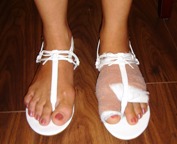Hallux Valgus

What is hallux valgus?
Hallux valgus, or bunion, is a painful deformity of the forefoot at the level of the first metatarsophalangeal (MTP) joint, in which there is medial angulation of the first metatarsal bone and the lateral deviation of the hallux. "Hallux" refers to the great toe, and "valgus" refers to the inward leaning of the great toe towards the second toe.
What are the causes?
• Family history. In the juvenile and adolescent hallux valgus, heredity seems to play a major role.
• Gender. The incidence of bunions in females versus males is 9:1. It may be secondary to improper footwear especially the use of high heels with pointed toe boxes.
• Other ankle and foot disorders. Flat feet, excessive ligamentous flexibility, systemic inflammatory diseases (e.g. rheumatoid arthritis, psoriasis), abnormal bone structure, and contracted Achilles/gastrocnemius are suggested contributing factors to the development of bunions.
What are the signs and symptoms?
• Enlargement of bone or tissue around the joint at the base of the big toe (MTP joint).
• The big toe may turn in toward the second toe (angulation). In the worst case, the big toe may even overlap it.
• The tissues surrounding the MTP joint may be swollen and tender. Sometimes, callus will develop under the second metatarsal head as a result of transfer metatarsalgia (inflammation of metatarsal bone). This can also be painful.
What is the available treatment?
Mild conditions of bunion can be treated conservatively by physiotherapy (electrotherapy for pain relief and anti-inflammation, therapeutic exercise for strengthening foot intrinsic muscles, foot wear advice and prescription of Orthotics).
When conservative treatment fails or the condition becomes severe, surgery is indicated. The primary goal of bunion surgery is to remove pain and correct deformity so that patient can walk more comfortably. The operative procedures may involve release of adjacent soft tissues, removal of abnormal bony enlargement, osteotomy (removal of bone) and screw fixation which realign and straighten the big toe. With newer delicate surgical techniques, patient can start walking immediately and crutches are needed for only a few days after the operation, depending on age and health of patient, and surgeon's skills. In general, a patient can expect a period of 6-12 weeks towards full recovery. Talk to our surgeon if you want to know more.
THIS MATERIAL DOES NOT CONSTITUTE MEDICAL ADVICE. IT IS INTENDED FOR INFORMATIONAL PURPOSES ONLY. PLEASE CONSULT A PHYSICIAN FOR SPECIFIC TREATMENT RECOMMENDATIONS.
